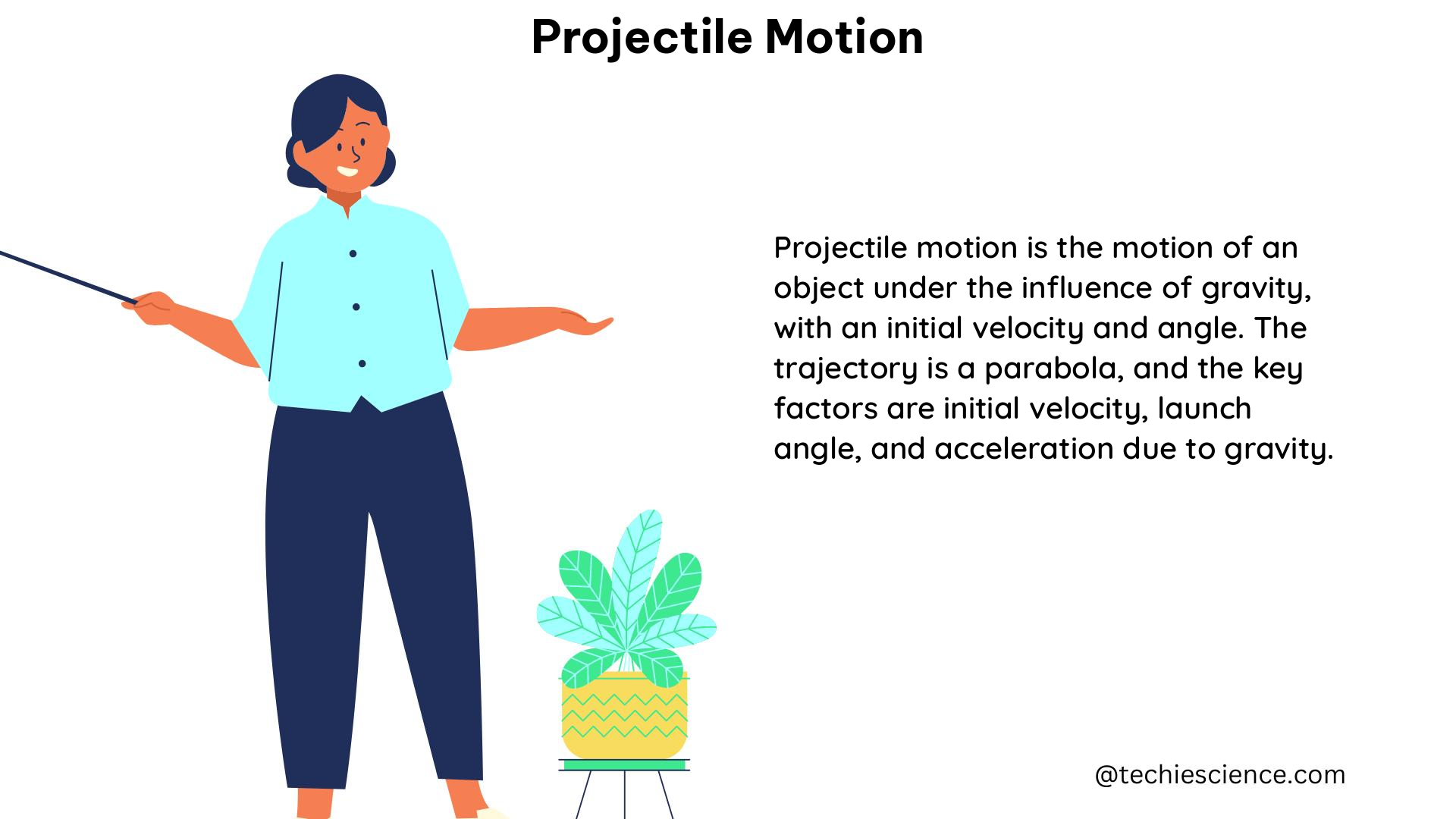Projectile motion is the motion of an object that is projected into the air and moves under the influence of gravity. The key concept to remember is that motions along perpendicular axes are independent, meaning they can be analyzed separately. This allows for the decomposition of projectile motion into two separate motions: one along the horizontal axis and the other along the vertical.
Understanding the Kinematics of Projectile Motion
Horizontal Motion
The horizontal motion of a projectile is characterized by constant velocity. The horizontal range of the motion can be found using the equation:
$x = v_x \cdot t$
where:
– $x$ is the horizontal displacement (range)
– $v_x$ is the horizontal velocity
– $t$ is the time of flight
Vertical Motion
The vertical motion of a projectile is accelerated motion due to gravity. The time of flight, or the total time the object is in the air, can be found using the equation:
$T = \frac{2 \cdot v_{0y}}{g}$
where:
– $T$ is the time of flight
– $v_{0y}$ is the initial vertical velocity
– $g$ is the acceleration due to gravity (9.8 m/s^2)
The maximum height of the projectile can be found using the equation:
$h_{max} = \frac{v_{0y}^2}{2 \cdot g}$
Trajectory
The trajectory of the projectile, or its path through the air, can be found by combining the equations for horizontal and vertical motion:
$y = x \tan \theta – \frac{gx^2}{2v_0^2 \cos^2 \theta}$
where:
– $y$ is the vertical displacement
– $\theta$ is the launch angle
– $v_0$ is the initial velocity
Laboratory Experiments and Data Analysis

In laboratory settings, the kinematics model for simple projectile motion can be tested using various equipment, such as:
- Inclined plane
- Guided track
- Science Workshop interface
- Photogates
- Time-of-Flight Accessory
- Lab jack
- Ball
- Metric ruler
- Plumb bob
- Masking tape
The data analysis process typically involves:
- Building graphs to visualize the motion
- Finding the launched theoretical velocity and its uncertainty
- Calculating the percent discrepancy between experimental and theoretical values
- Finding the free fall acceleration and its uncertainty
- Comparing experimental and theoretical values
Practical Investigations
In the context of a practical investigation, the relationship between the launch velocity and the range of a projectile is linear, with the range being dependent on the time of flight and the horizontal velocity. By expressing the time of flight in terms of the acceleration due to gravity, the range can be expressed in terms of the horizontal velocity and other control variables such as height and acceleration due to gravity.
For example, consider a projectile launched from a height $h$ with an initial velocity $v_0$ and launch angle $\theta$. The range of the projectile can be expressed as:
$R = \frac{v_0^2 \sin 2\theta}{g}$
where:
– $R$ is the range of the projectile
– $v_0$ is the initial velocity
– $\theta$ is the launch angle
– $g$ is the acceleration due to gravity
This equation demonstrates the linear relationship between the launch velocity and the range, as well as the dependence on the launch angle and the acceleration due to gravity.
Numerical Examples
- Example 1: Projectile Motion with Known Initial Velocity and Angle
- Initial velocity, $v_0 = 50 \, \mathrm{m/s}$
- Launch angle, $\theta = 30^\circ$
- Acceleration due to gravity, $g = 9.8 \, \mathrm{m/s^2}$
- Calculate the maximum height and the range of the projectile.
Solution:
– Maximum height:
$h_{max} = \frac{v_0^2 \sin^2 \theta}{2g} = \frac{(50 \, \mathrm{m/s})^2 \sin^2 30^\circ}{2 \cdot 9.8 \, \mathrm{m/s^2}} = 31.25 \, \mathrm{m}$
– Range:
$R = \frac{v_0^2 \sin 2\theta}{g} = \frac{(50 \, \mathrm{m/s})^2 \sin 60^\circ}{9.8 \, \mathrm{m/s^2}} = 100 \, \mathrm{m}$
- Example 2: Projectile Motion with Unknown Initial Velocity
- Maximum height, $h_{max} = 25 \, \mathrm{m}$
- Acceleration due to gravity, $g = 9.8 \, \mathrm{m/s^2}$
- Calculate the initial vertical velocity.
Solution:
– Initial vertical velocity:
$v_{0y} = \sqrt{2gh_{max}} = \sqrt{2 \cdot 9.8 \, \mathrm{m/s^2} \cdot 25 \, \mathrm{m}} = 22.14 \, \mathrm{m/s}$
- Example 3: Projectile Motion with Unknown Launch Angle
- Range, $R = 80 \, \mathrm{m}$
- Initial velocity, $v_0 = 40 \, \mathrm{m/s}$
- Acceleration due to gravity, $g = 9.8 \, \mathrm{m/s^2}$
- Calculate the launch angle.
Solution:
– Launch angle:
$\theta = \tan^{-1} \left(\frac{gR}{v_0^2}\right) = \tan^{-1} \left(\frac{9.8 \, \mathrm{m/s^2} \cdot 80 \, \mathrm{m}}{(40 \, \mathrm{m/s})^2}\right) = 45^\circ$
These examples demonstrate the application of the key equations and concepts in projectile motion, allowing you to solve for various unknown quantities based on the given information.
Conclusion
Projectile motion is a fundamental concept in physics that combines horizontal constant velocity motion and vertical accelerated motion due to gravity. By understanding the kinematics equations, you can analyze and predict the motion of projectiles, including their range, maximum height, and trajectory. Laboratory experiments and practical investigations provide opportunities to test the theoretical models and explore the relationships between the various parameters involved in projectile motion.
References
- OpenStax, “Projectile Motion,” University Physics Volume 1, 2016.
- University Physics Volume 1, “Projectile Motion,” Pressbooks, 2022.
- WebAssign, “Projectile Motion,” Lab Manual, 2022.
- Learnable Education, “Year 12 Physics Practical Investigation | Projectile Motion Experiment,” 2021.
- Brandon Fleming, “Experiment 08 – Projectile Motion,” YouTube, 2018.

The lambdageeks.com Core SME Team is a group of experienced subject matter experts from diverse scientific and technical fields including Physics, Chemistry, Technology,Electronics & Electrical Engineering, Automotive, Mechanical Engineering. Our team collaborates to create high-quality, well-researched articles on a wide range of science and technology topics for the lambdageeks.com website.
All Our Senior SME are having more than 7 Years of experience in the respective fields . They are either Working Industry Professionals or assocaited With different Universities. Refer Our Authors Page to get to know About our Core SMEs.